|
| |
|
What's Cookin'?
by Bob Brooke
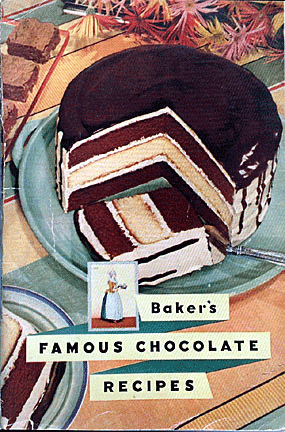 People
collect cookbooks for lots of reasons. Some collect vintage cookbooks.
Others collect cooking pamphlets distributed by food companies, such as
Baker’s Coconut, that advertise a particular product. While still others
focus on their own region or cookbooks written by celebrities. People
collect cookbooks for lots of reasons. Some collect vintage cookbooks.
Others collect cooking pamphlets distributed by food companies, such as
Baker’s Coconut, that advertise a particular product. While still others
focus on their own region or cookbooks written by celebrities.
There are also cookbooks that focus on a particular food or lack of it,
such as those with fat-free or chocolate recipes. Some cookbook
collectors, just as general book collectors, look for association
copies.
Cookbook History
According to historians, Archestratus, a Greek philosopher who lived
around 350 B.C.E, wrote the world’s first cookbook. But the earliest
surviving one, De Re Coquinaria, or On Cookery, attributed to a first
century Roman gourmet named Apicius, who believed in the extensive use
of fresh herbs and seasonings, dates to 100 A.D. Republished in London
in 1958, it’s even more relevant today.
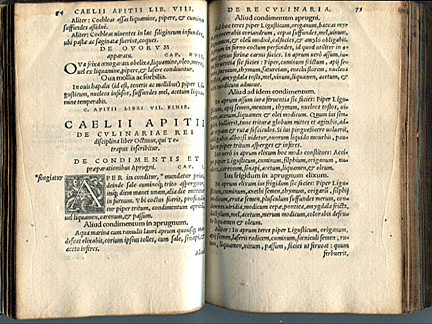 The
first American cookbook, The Complete Housewife, or Accomplish 'd
Gentlewoman's Companion, published in Williamsburg, didn’t appear until
1742. And for the following 100 years, cookbook authors targeted their
books to trained chefs with lots of helpers. It wasn’t until 1845 in
London that Eliza Acton's Modern Cookery for Private Families provided a
basic cookbook for the everyday housewife. The
first American cookbook, The Complete Housewife, or Accomplish 'd
Gentlewoman's Companion, published in Williamsburg, didn’t appear until
1742. And for the following 100 years, cookbook authors targeted their
books to trained chefs with lots of helpers. It wasn’t until 1845 in
London that Eliza Acton's Modern Cookery for Private Families provided a
basic cookbook for the everyday housewife.
A few years later, Sarah Willis, best known as Fanny Farmer, wrote that
famous quote, "The way to a man's heart is through his stomach."
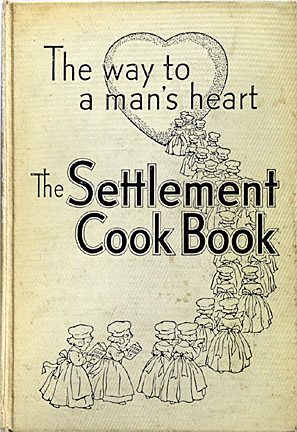 Nevertheless,
other writers took her quote to heart and produced their own cookbooks.
Cookbooks with titles such as the Young Wife's Own Cook Book by Mrs.
Jane Warren , How to Cook Your Husband and Other Things, by Puritan
Millers, and 15 Ways to a Man's Heart by Betty Crocker, began to appear
on bookstore shelves. Nevertheless,
other writers took her quote to heart and produced their own cookbooks.
Cookbooks with titles such as the Young Wife's Own Cook Book by Mrs.
Jane Warren , How to Cook Your Husband and Other Things, by Puritan
Millers, and 15 Ways to a Man's Heart by Betty Crocker, began to appear
on bookstore shelves.
While each of these women may have found the way to a man's heart,
Fannie Merritt Farmer found the key to the heart of the American public.
Farmer graduated from the Boston Cooking School in 1889, and in 1891,
she began serving as its director, a position she held until 1902. It
was then she opened Miss Farmer’s School of Cookery, which focused on
training housewives and nurses.
Farmer was an early advocate of accurate measurement in recipes. While
she’s best known for editing The Boston Cooking-School Cook Book,
published in 1896, The book's publisher, Little, Brown & Company, didn’t
predict good sales and limited the first edition to 3,000 copies, which
Farmer had to pay for herself. The book was so thorough and
comprehensive that it became an instant hit in America. Cooks would
refer to later editions simply as the Fannie Farmer Cookbook, which is
still available in print over a century later.
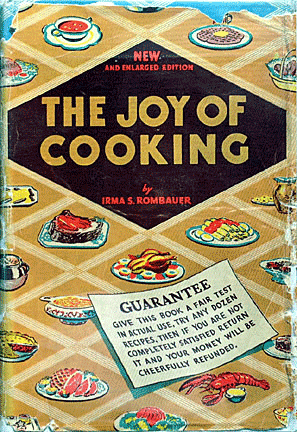 Another
major cookbook is The Joy of Cooking. In 1931, recently widowed Irma von
Starkloff Rombauer needed a way to support her family, and
self-published The Joy of Cooking: A Compilation of Reliable Recipes
with a Casual Culinary Chat., She had only 3,000 copies printed, making
first editions very rare. Today, one sells for over $1,500, and the
addition of an original dust jacket raises the cost further. Another
major cookbook is The Joy of Cooking. In 1931, recently widowed Irma von
Starkloff Rombauer needed a way to support her family, and
self-published The Joy of Cooking: A Compilation of Reliable Recipes
with a Casual Culinary Chat., She had only 3,000 copies printed, making
first editions very rare. Today, one sells for over $1,500, and the
addition of an original dust jacket raises the cost further.
Rombauer's The Joy of Cooking was a huge success. In1936, Bobbs-Merrill
Company published it commercially featured both Irma Rombauer and her
daughter, Marion Becker, as co-authors. Today, serious cooks acknowledge
it to be the first cookbook to list ingredients in order of use,
followed by a list of chronological instructions.
The Joy of Cooking has also never been out of print, although the book
did undergo major revisions in 1975 and 1997.
How to Start a Cookbook Collection
Beginning collectors can assemble an interesting collection by paying no
more than $3 to $25 per book. Flea markets, antique shops and malls,
school and library sales, used bookstores and online auctions such as
eBay are all good sources.
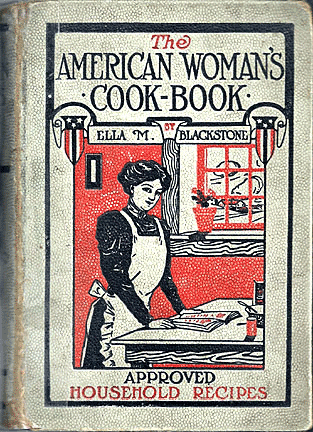 Some
people collect only pamphlets put out by various food manufacturers,
such as Arm & Hammer Baking Soda, Gold Medal Flour, Mazola Oil, Jell-O,
Wilbur's Cocoa, Sunkist Oranges, Puritan Meats, Quaker Oats and
Fleischmann's Yeast, to name a few. Collectors love these pamphlets,
advertising food products from the late 1800s through the 1940s, for
their brightly colored, beautifully lithographed covers; Some
people collect only pamphlets put out by various food manufacturers,
such as Arm & Hammer Baking Soda, Gold Medal Flour, Mazola Oil, Jell-O,
Wilbur's Cocoa, Sunkist Oranges, Puritan Meats, Quaker Oats and
Fleischmann's Yeast, to name a few. Collectors love these pamphlets,
advertising food products from the late 1800s through the 1940s, for
their brightly colored, beautifully lithographed covers;
Church or charity fund-raising cookbooks are another possibility, as are
regional cookbooks. Some collectors seek out cookbooks published during
either World War I or II, such as War Bread Recipes, published in 1918,
or The Wartime Cook Book, published in 1942.
Another area often overlooked by beginning collectors are cookbooks
associated with newly-invented small appliances or cookware such as
chafing dishes, canning supplies, stoves, refrigerators and Pyrex glass
product cookbooks.
Finding Collectible Cookbooks
Beginning cookbook collectors will find a wide variety at church
bazaars, Goodwill and Salvation Army stores, book fair and library
sales, as well as mall shows. Other venues that offer possibilities are
antique and paper and postcard collectible shows, although prices may be
higher.
Also, novice collectors shouldn’t ignore newer cookbooks. First editions
and artist cookbooks, such as the hard-to-find Salvador Daft Cookbook,
published in 1965, and the Salvador Dali Winebook. These are amazingly
and strangely illustrated, and, in fine condition with dust jackets,
selling for between $250 and $275.
What Cookbooks to Collect
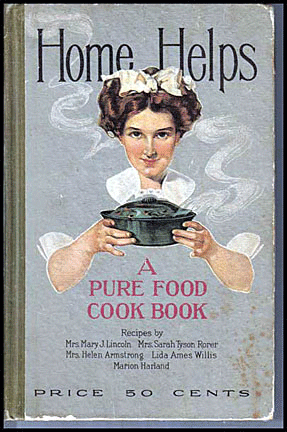 Beginning
collectors should narrow their field of concentration. Some areas to
consider are famous names in the cooking business such as Fannie Farmer,
who edited The Boston Cooking School Cook Book in 1896, Chafing Dish
Possibilities in 1898, What to Have for Dinner, in 1905, as well as
pamphlets for such products as Rumford Yeast. Others include Catherine
Beecher and Harriet Beecher Stowe, co-authors of The American Woman's
Home or Principles of Domestic Science in 1869, Marion Harland, author
of The Dinner Yearbook in 1878, and the National Cook Book, published in
1904, in collaboration with her daughter, Christine Terhune Herrick, and
The Complete Cook Book, published in 1903. Beginning
collectors should narrow their field of concentration. Some areas to
consider are famous names in the cooking business such as Fannie Farmer,
who edited The Boston Cooking School Cook Book in 1896, Chafing Dish
Possibilities in 1898, What to Have for Dinner, in 1905, as well as
pamphlets for such products as Rumford Yeast. Others include Catherine
Beecher and Harriet Beecher Stowe, co-authors of The American Woman's
Home or Principles of Domestic Science in 1869, Marion Harland, author
of The Dinner Yearbook in 1878, and the National Cook Book, published in
1904, in collaboration with her daughter, Christine Terhune Herrick, and
The Complete Cook Book, published in 1903.
Other cookbooks to collect include hardcover editions that are old
and/or scarce, association books or pamphlets such as those picturing
radio star Jack Benny, musical star Kate Smith, theater personality
Ethel Barrymore or movie actress Gloria Stuart. Advertising pamplets
showcasing innumerable products in recipes featuring Sun-Maid Raisins,
with the biggest selection, is the a favorite of collectors.
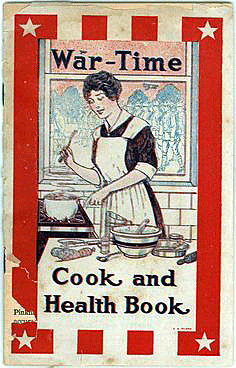 Some
people collect a specific product, such as Jell-O or Bisquick, while
others might collect cookbooks specializing in cakes or cookies. Most of
these cookbooks and pamphlets, even the very early ones, can still be
found for less than $50. Some
people collect a specific product, such as Jell-O or Bisquick, while
others might collect cookbooks specializing in cakes or cookies. Most of
these cookbooks and pamphlets, even the very early ones, can still be
found for less than $50.
Another interesting niche is the charitable cookbook, often published
for neighborhood schools, churches or local charities. Early examples
are usually rare, with prices starting at around $35. Examples include
The Eskimo Cook. Book by Alaska Crippled Children's Association (1951,
$35), Oakland Ladies Aid Cook Book by Ladies' Aid Society (1902, $175),
How We Cook in Colorado by Ladies of the 1st Baptist Church (1907, $200)
and PTA Secrets by Round Rock PTA (1924, $50).
There must be plenty of attics and basements still full of grandma's
cookbook collection. You might find them all together in a box at a yard
or tag sale, uninteresting to those looking for vintage linen, art
pottery or Nippon china, but just waiting for you.
< Back to Collecting Archives
Next Article >
|
|

|
|
FOLLOW MY WEEKLY BLOG
Antiques Q&A
JOIN MY COLLECTION
Antiques and More
on Facebook
LIKE MY FACEBOOK PAGE
The Antiques
Almanac on Facebook |
|
No antiques or collectibles
are sold on this site.
|
|
How to Recognize and
Refinish Antiques for Pleasure and Profit
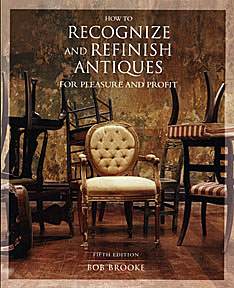
Have
you ever bought an antique or collectible that was less than perfect and
needed some TLC? Bob's new book offers tips and step-by- step
instructions for simple maintenance and restoration of common antiques.
Read an
Excerpt
|
|

|
|
|
|
|
